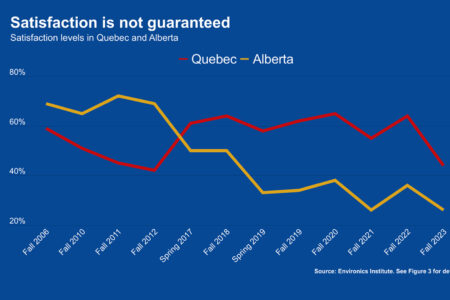
The post-election dust has finally settled in Alberta. With a land- slide win in early March, Premier Ed Stelmach and his Progressive Conservative Party have more or less clinched their celebration in 2011 of 40 years of uninterrupted rule in the province. This kind of one-party tenure is unheard of in a liberal democracy.
But to say the Tories ”œwon” on March 4 is not quite right. It was a bludgeoning. Ed Stelmach, the meek and mild farmer from northern Alberta, took 72 of the 83 seats in the legislature, and more than half of the popular vote (no small feat given there were five parties running).
On election night, the province was stunned. And to be honest, no one looked more surprised than Stelmach himself. It was a pretty safe bet that Steady Eddie (as he is called out here) would win the election, but few pre- dicted this sort of drubbing of the Liberals. Most of the pundits were pre- dicting a drop in Tory seats to perhaps around 50 or 55 seats (they held 60 going into the election).
Before the campaign, there were even some whispers of a minority gov- ernment. Calgary, it was thought, was fed up with the Tories and would lean toward Kevin Taft and the Liberals. For most of the 14 months Stelmach had been in power, he seemed out of touch with the energy patch, represented rural Alberta and just didn’t seem up to the job of leading the hottest economy in North America. He just wasn’t what Calgary’s yoga-and-cappuccino crowd envisioned as a premier.
Polls were suggesting that change was in the air. Albertans wanted change, or at least that’s what they told the pollsters. And throughout the campaign, the number of undecided voters was dangerously high for the Tories. Coupled with the apparent lust for change in the province, this was making the opposition parties salivate. What went wrong for the Liberals? Why didn’t ”œchange” happen? How could Alberta ”” a province seemingly desperate for change ”” hand over a massive majority to the same party that has ruled since The Brady Bunch ruled the afternoon airwaves?
Certainly Taft and his Liberal team gave it a good shot. But if you didn’t like Stelmach’s increased take of energy roy- alties (he’s raising them by some 20 per- cent), you weren’t going to find a better offering among the Liberals. And in other policy areas ”” eliminating health care premiums, investing energy royal- ties for the future, etc. ”” there really wasn’t much to distinguish the Liberals’ plan from the Conservatives. Part of the explanation of the Tories’ win could be in what poll respondents really meant when they said they wanted change. What kind of change? How much change? And how much of a gamble are you willing to take on an untried party?
The low voter turnout in Alberta on election night was disgraceful. Only about 40 percent of eligible voters cast a ballot. So with roughly half the popular vote, the Tories were elected by only a fifth of the adult population. But that, coupled with the wonky rural-heavy seat distribution in Alberta, was enough to translate into 87 percent of the seats in the legislature.
The Tories really have the many ”œnon-voters” to thank for their land- slide win. We don’t know for sure how many of these non-voters were unde- cided versus disgruntled Tory support- ers. But for both groups, there was no viable ”œchange” offered on the ballot.
So that left the undecided voters and the disgruntled Tory voters with a dilemma: vote for someone untried (Taft), uninspiring (Taft) and invisible during the campaign (Taft), or vote for someone tried (Stelmach), equally uninspiring (Stelmach) and the safest choice (Stelmach).
Or, a third option, stay home and watch a rerun of Law and Order. At least with the latter, there would have been a chance of some suspense. Some 60 percent of Albertans took that option.
Simply put, the undecided voters may have been looking for some options for change during the cam- paign. Some of them may even have been desperate for change. But, sadly, they just didn’t find it on the ballot. So the 20 percent of Albertans who were satisfied with the status quo swept the Tories back into power.
When Ed Stelmach first rose to power in December 2006, it was often observed: ”œHe sure ain’t Ralph Klein!” ”” a stinging commentary that Stelmach just wasn’t up to filling Klein’s very big shoes. But, ironically, not being Ralph Klein could be what ultimately worked in Stelmach’s favour.
Klein ”” who rose to cultlike pop- ularity during the first half of his reign as premier ”” successfully came across as the man of the people. He had a style and cachet about him that, while not everyone liked it, was distinct and unique. Stelmach, on the other hand, seems to fill the room with ether.
But what Stelmach lacks in charis- ma, he seems to make up for in hon- esty and decency. He’s somehow like a trusted uncle, or maybe the Maytag repairman.
The critics were right: Stelmach is no Klein. And that, it seems, was change enough to satisfy Alberta.







